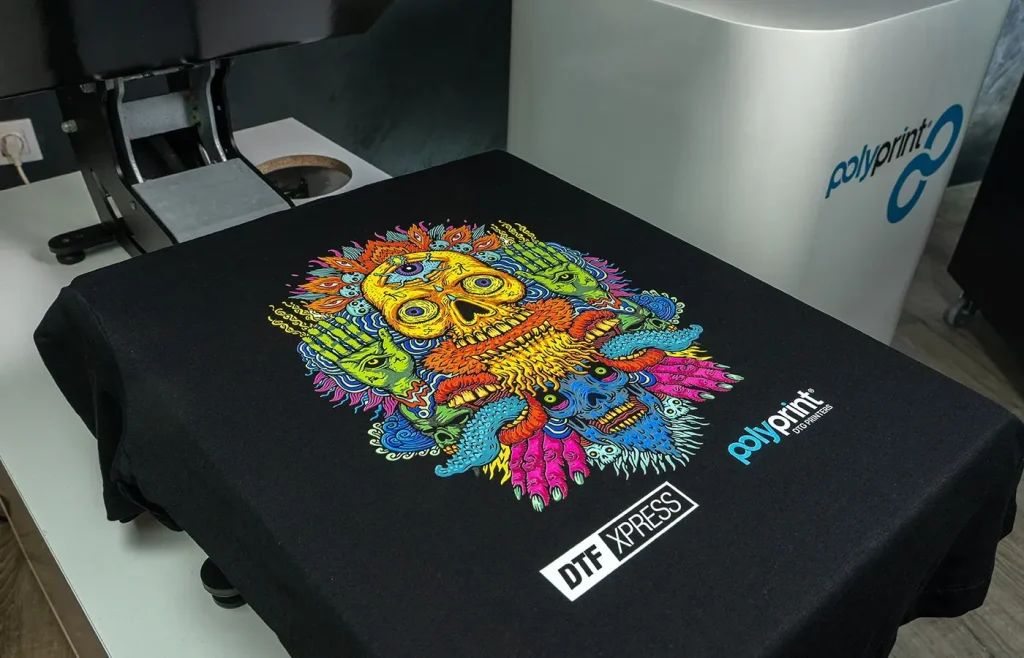DTF printing design, or Direct to Film printing, is rapidly transforming the landscape of custom apparel, allowing designers to express their creativity in vibrant and durable ways. This revolutionary printing technique not only enhances the quality of prints but also enables intricate designs to be easily transferred onto various fabrics. By understanding DTF transfer techniques and mastering key design elements, you can elevate your apparel customization projects to new heights. In this guide, we will explore essential DTF printing tips that ensure your creative vision is flawlessly realized, from the initial concept to the final product. Whether you’re a beginner or a seasoned pro, learning how to effectively design for DTF printing can set you apart in the competitive fashion industry.
Exploring the world of Direct to Film printing design opens the door to endless possibilities for artistic expression in custom garments. Known for its ability to produce vibrant colors and detailed imagery, this innovative printing method is often favored by fashion enthusiasts for its flexibility and affordability. Various DTF transfer techniques allow for easy application on different fabric types, making it a go-to choice for apparel customization projects. Understanding the nuances of designing for DTF printing is crucial, especially when it comes to maximizing visual impact and ensuring long-lasting results. As we delve deeper into this exciting field, you’ll discover the vital tips and tricks that can help you create stunning, professional-quality prints.
Exploring the Advantages of DTF Printing
DTF printing, or Direct to Film printing, is a game changer in the realm of custom fabric designs. One of its primary advantages is unmatched versatility; DTF transfers can be applied to a broad array of fabric types, including cotton, polyester, and blends. This flexibility makes it an appealing choice for businesses and individuals alike who wish to create unique apparel. Furthermore, DTF printing allows for vivid color reproduction, bringing designs to life with brightness and accuracy. Whether creating a one-off piece or an entire batch of shirts, DTF can accommodate varying order sizes economically.
Another significant advantage of DTF printing is the minimal setup required compared to traditional screen printing methods. There’s no need for costly screens or complicated setups, allowing creators to quickly move from idea to final product without extensive financial investment. This opens the doors for both budding entrepreneurs and seasoned designers to experiment with various designs more freely and create unique offerings without the burden of large production runs.
Key Design Techniques for DTF Printing Success
When it comes to designing for DTF printing, embracing a few key techniques can elevate your print quality significantly. First and foremost, using an RGB color profile during design creation helps maximize color richness since this model captures a broader spectrum that often translates beautifully to printed results. Furthermore, performing test prints under various conditions enables you to gauge color accuracy and adjust designs accordingly before committing to a full production run.
Incorporating bold graphic elements and clear typography is also essential in designing for DTF. Complex images may lose clarity during the transfer process, making it critical to keep designs straightforward and impactful. When selecting fonts for text-based designs, consider legibility from a distance; choosing a typeface that maintains its integrity when printed ensures your message is communicated effectively.
Essential Tools and Software for Designing DTF Transfers
Choosing the right software for creating your DTF designs can significantly influence the outcome of your projects. Adobe Illustrator is often regarded as the industry standard for its robust vector editing capabilities, allowing for intricate designs that can be scaled without losing quality. Additionally, CorelDRAW is a powerful alternative that many designers prefer due to its intuitive interface and array of design tools well-suited for apparel customization.
For those looking for budget-friendly options, Inkscape provides an excellent open-source alternative that still offers a wide range of design features to support the creation of high-quality DTF images. Regardless of the software you choose, ensuring it supports high-resolution outputs and different file formats suitable for DTF printing, such as PNG and TIFF, is crucial to achieving vibrant and lasting results.
Applying Your DTF Designs: Techniques and Tips
Applying your DTF designs correctly is vital for ensuring the end product meets quality expectations. The use of a reliable heat press machine is recommended to guarantee even temperature distribution and pressure during the transfer process. Adhering to specified temperature and time guidelines will lead to optimal adhesion between the design and fabric. Generally, setting the heat press to about 320°F (160°C) for 10 to 15 seconds is effective for most fabrics.
Additionally, pre-heating your fabric for a few seconds before applying the transfer can help eliminate moisture and ensure better adhesion. Post-application, allow your design to cool completely to solidify the bond effectively. Conducting a wash test after your initial application can also help assess the durability of your print, ensuring it withstands wear and repeated laundering without fading or peeling.
The Importance of Testing Your DTF Designs
Testing is a crucial step in the DTF printing process that not only applies to the application but also to the design itself. Prior to launching your product line, executing test runs allows you to check for any discrepancies between the digital design and the printed outcome. This may involve examining color accuracy, adherence quality, and overall design clarity.
Furthermore, performing wash tests is essential as it simulates real-world use and helps ensure that your DTF prints maintain their integrity under regular washing conditions. By doing this diligence before entering mass production, you can mitigate risks and increase the satisfaction of your end users.
Future Trends in Custom Apparel and DTF Printing
As the world of custom apparel continues to evolve, DTF printing is becoming increasingly integrated into modern garment production trends. The ability to create bespoke, limited-run designs on-demand is appealing for both brands and consumers who value uniqueness in their clothing. With advancements in DTF technology, we can also expect enhancements in speed and quality, making it easier than ever to produce high-quality and detailed designs.
Moreover, the rise of sustainable fashion practices has encouraged more designers to adopt DTF printing as a means to minimize waste. By allowing shorter production runs and offering customization, DTF printing aligns well with the growing consumer demand for eco-friendly options that do not sacrifice quality. As such, keeping an eye on these market trends can help designers harness the full potential of DTF printing for their creative endeavors.
Frequently Asked Questions
What is DTF printing and how does it work?
DTF printing, or Direct to Film printing, is a technique where designs are printed onto a special film and then transferred to various fabrics. This process allows for vibrant, high-quality images that are both durable and suitable for custom apparel.
What are the best design tips for DTF printing?
When designing for DTF printing, focus on bold and simple designs, use an RGB color profile for better color accuracy, ensure a resolution of at least 300 DPI, and choose high-quality file formats like PNG or TIFF for optimal results.
How do I test my design for DTF printing?
Before committing to full production, execute test prints to check for color accuracy and adhesion. Be sure to perform wash tests to ensure the durability of your DTF print, confirming it can withstand multiple washes without fading or cracking.
Which software should I use for designing DTF prints?
Popular software for designing DTF prints includes Adobe Illustrator for vector graphics, CorelDRAW for powerful illustration tools, and Inkscape as a free alternative. These programs help create intricate designs suitable for the DTF printing process.
What file formats are recommended for DTF printing designs?
For DTF printing, it is best to use file formats that support high quality and transparency, such as PNG or TIFF. These formats minimize quality loss during the conversion process and ensure sharp details in your final print.
What are the key steps in the DTF transfer process?
Creating a DTF transfer involves printing your design on a special film, applying an adhesive powder, and then using a heat press machine to transfer the design onto the fabric. It’s crucial to maintain proper temperature and pressure during this process for optimal results.
| Key Points | Details |
|---|---|
| Understanding DTF Printing | DTF printing transfers designs onto fabric, producing vibrant, durable prints. It’s popular for custom apparel due to its cost-effectiveness. |
| Key Design Considerations | Focus on color management, resolution (300 DPI), and use PNG or TIFF formats for quality. |
| Using Design Software | Recommended software includes Adobe Illustrator, CorelDRAW, and Inkscape for creating DTF designs. |
| Design Elements | Keep designs bold and simple, choose clear fonts, and utilize complementary colors. |
| Creating the Transfer | Print the design, apply adhesive powder, then heat press to fabric for durability. |
| Heat Application Techniques | Follow manufacturer guidelines for temperature (320°F) and pressure during heat application. |
| Testing Your Design | Perform test runs to check adhesion and conduct wash tests for durability. |
| Market Trends | Customization and versatility drive the popularity of DTF printing in the apparel market. |
Summary
DTF printing design offers a revolutionary approach in the world of custom fabric printing, allowing designers and creators to bring their visions to life with remarkable color and durability. By understanding the nuances of the DTF printing process, from color management to the selection of appropriate design software, you can create stunning prints that last. As more opportunities for creativity in custom apparel emerge, it is essential to stay informed about industry trends and best practices. With a robust foundation in the principles of DTF printing, enthusiasts and professionals alike can navigate the journey from concept to creation, ensuring their designs resonate with audiences and stand the test of time.



